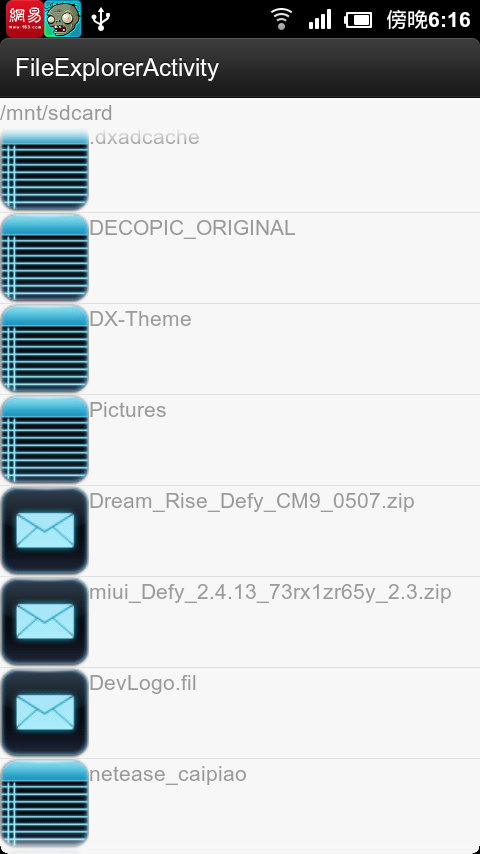学习Android,应该在掌握单个知识点之后,把多个知识点串联起来实现一些有一定代码量的小项目比较好。当然,这也是我教学中总结出来的一点经验心得,并不适合所有人。
先做需求分析(实现的功能):
1.ListView开始显示sdcard目录下的子目录和文件。
2.点击文件,Toast显示“点击的是文件”
3.点击目录,进入子目录,显示子目录下的子目录和文件。
4.back键回退到上层目录。
5.异常情况处理:
5.1如果sdcard没有插入,则不显示列表,且提示用户应该插入sdcard后操作
5.2不允许进入sdcard的上层目录
下面开始实现:
布局有两个:
1.主布局:file_list.xml
<RelativeLayout xmlns:android="http://schemas.android.com/apk/res/android" xmlns:tools="http://schemas.android.com/tools" android:layout_width="match_parent" android:layout_height="match_parent" tools:context=".FileExplorerActivity" > <TextView android:id="@+id/currentTv" android:layout_alignParentTop="true" android:clickable="true" android:layout_width="match_parent" android:layout_height="wrap_content"/> <ListView android:id="@+id/fileLv" android:layout_below="@id/currentTv" android:layout_alignParentBottom="true" android:layout_width="match_parent" android:layout_height="wrap_content"> </ListView> </RelativeLayout>
布局很简单,就是放置了一个ListView控件,这里要注意的是,ListView标签下不能再放入其他的子控件。内容是通过子布局和Adapter来显示的。
2.ListView中的子布局file_list_item.xml
<?xml version="1.0" encoding="utf-8"?><LinearLayout xmlns:android="http://schemas.android.com/apk/res/android" android:layout_width="match_parent" android:layout_height="match_parent" android:orientation="horizontal" > <ImageView android:id="@+id/icon" android:layout_width="wrap_content" android:layout_height="wrap_content" /> <TextView android:id="@+id/filename" android:layout_width="wrap_content" android:layout_height="wrap_content"/></LinearLayout>子布局也很简单,就是在水平方向上左边显示一个图标,用来显示文件夹或文件图标,右边显示文件名。
3.Activity代码(功能点写在注释中)
public class FileExplorerActivity extends Activity { //Adapter中ICON和Filename键值对常量 private static final String ICON = "icon"; private static final String FILENAME = "filename"; private TextView currentTv;//ListView上显示当前路径的TextView private ListView fileLv;//文件列表显示的ListView SimpleAdapter adapter;//适配器 private List<HashMap<String, Object>> data;//填充的数据 private File root;//文件夹根节点 private File[] currentFiles; //根节点下的所有文件(包括文件夹) private File currentPath;//记录当前节点 @Override protected void onCreate(Bundle savedInstanceState) { super.onCreate(savedInstanceState); setContentView(R.layout.activity_file_explorer); currentTv = (TextView)findViewById(R.id.currentTv); fileLv = (ListView)findViewById(R.id.fileLv); //得到根节点root -->/mnt/sdcard root = getFileSystemRoot(); //得到第一屏的信息 if(root != null){ //从/mnt/sdcard下得到文件列表 data = getFileListFromSdcard(root); }else{ //如果没有挂载sdcard,则提示用户 data = new ArrayList<HashMap<String, Object>>(); HashMap<String, Object> map = new HashMap<String, Object>(); map.put(ICON, R.drawable.none); map.put(FILENAME, "逗我玩啊,插卡啊"); data.add(map); } //创建Adapater adapter = new SimpleAdapter( this, data, R.layout.file_list_item, new String[]{ICON, FILENAME}, new int[]{R.id.icon, R.id.filename}); fileLv.setAdapter(adapter); //绑定事件 fileLv.setOnItemClickListener(new OnItemClickListener() { @Override public void onItemClick(AdapterView<?> parent, View view, int position, long id) { //点击listview 项时,如果是目录,则进入下一层次,如果是文件,不做处理 File currentPosFile = currentFiles[position]; if(currentPosFile.isDirectory()){ getFileListFromSdcard(currentPosFile); }else{ Toast.makeText(FileExplorerActivity.this, "您点击的是文件夹", Toast.LENGTH_LONG).show(); } } }); } /** * 拦截back键返回 * @return */ @Override public boolean onKeyDown(int keyCode, KeyEvent event) { if(KeyEvent.KEYCODE_BACK == keyCode){ File parentFile = currentPath.getParentFile(); //不能超过最顶层 try { if(parentFile.getCanonicalPath().toString().equals("/mnt")){ Toast.makeText(this, "别按了,到家了", Toast.LENGTH_LONG).show(); return true; }else{ getFileListFromSdcard(parentFile); } } catch (IOException e) { e.printStackTrace(); } } return super.onKeyDown(keyCode, event); } private File getFileSystemRoot() { //首先得到Sd卡是否加载了 if(Environment.MEDIA_MOUNTED.equals(Environment.getExternalStorageState())){ //得到sd卡路径 root --> /mnt/sdcard root = Environment.getExternalStorageDirectory(); }else{ Toast.makeText(this, "逗我玩啊,插卡啊", Toast.LENGTH_LONG).show(); } return root; } /** * 得到Sdcard中的文件列表 * @return */ private List<HashMap<String, Object>> getFileListFromSdcard(File root) { try { currentPath = root; currentTv.setText(root.getCanonicalPath().toString()); } catch (IOException e) { e.printStackTrace(); } List<HashMap<String, Object>> list = new ArrayList<HashMap<String, Object>>(); currentFiles = root.listFiles();//列出当前目录下的所有文件和目录 for(File f : currentFiles){ HashMap<String, Object> map = new HashMap<String, Object>(); String fileName = f.getName(); int icon; if(f.isDirectory()){ icon = R.drawable.dir; map.put(ICON, icon); }else if(f.isFile()){ icon = R.drawable.file; map.put(ICON, icon); } map.put(FILENAME, fileName); list.add(map); } //把原来的data list清空,然后把list放进去,再通知adapter if(data != null){ data.clear(); data.addAll(list); adapter.notifyDataSetChanged(); } return list; }}运行效果:

功能展望:
以上代码是通过精简功能达到的,如果要增加以下功能也是相当之简单的:
1.文件夹和文件的删除功能
2.文件夹和文件的重命名功能
3.文件的分类调用App查看功能
4.文件详细信息显示功能
...
从上面示例可以看出,其实做一个文件资源管理器是相当简单的。